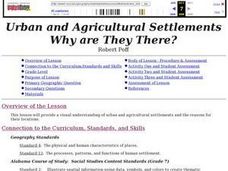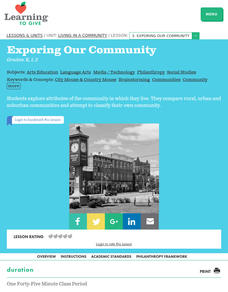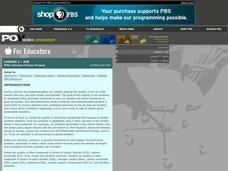Polk Bros Foundation
Analyze History
Determining the central idea of a historical event or theme involves identifying key points of information, such as the people and place involved in the history, challenges faced, and choices made. Your young historians can use this...
Polk Bros Foundation
History Dramatists
Bring the drama of history to life in your class and give your learners the opportunity to illustrate their understanding of a historical situation through the medium of a dialogue and/or play. Your young historians will consider a...
Curated OER
Communities
Students examine the similarities and differences between rural, suburban, and urban communities. They read about type of community in their social studies textbook, analyze the differences between Tokyo and Chicago, and complete a chart...
Curated OER
Urban and Agricultural Settlements Why are They There?
Seventh graders identify types of human settlements, urban and agricultural, and determine geographic influence on why people settle where they did by use of maps and charts. They, in groups, identify the needs of a new settlement, which...
Curated OER
Defining the Problem
In this problems worksheet, students use information they have collected about their campus and community to define one issue they are going to work on in depth. Students answer six questions about the problem they select, then complete...
Curated OER
Rap as a Modern Poetic Form
Students write and listen to rap songs. They discover how common themes in rap are indicative of the problems, as well as the empowerments, that can be seen in our urban cultures today. They discover how rap is actually an evolution of...
Curated OER
Country Comparison Chart
In this country comparison worksheet, students use their research skills to find the population, per-capita GDP, urban numbers, rise in population, literacy rate, and life expectancy of the each of the 10 nations listed.
Curated OER
Before the Industrial Revolution
In this European history worksheet, 12th graders respond to 18 short answer questions about European production, urban centers, and pre-Industrial Europe.
Curated OER
Exporing Our Community
Students explore attributes of the community in which they live. They compare rural, urban and suburban communities and attempt to classify their own community. Each group illustrates their assigned area by drawing buildings, trees,...
Curated OER
History of the American West
Ninth graders research early mining in California. They study the "placer method" for mining gold, which is surface mining that does not involve tunneling. They examine what it was like for the early miners to pan for gold with...
Curated OER
Homeless in our Community
Third graders explore homelessness in their local community. In this service project/social studies lessons, children research local areas where homeless people reside, discuss global acceptance and unity, and visit a local food bank.
Curated OER
Industrial Revolution
Learners cite the importance of the steam engine, cotton gin and steel making process. They describe conditions in cities due to increased industrialization. They explain how the living and working conditions led to the development of...
Curated OER
Urban New Haven in the Making (1920-1980)
Students read and discuss issues that are relevant to the community. They develop a sense of social efficacy that encourages participation in their community and identify with the local area, and can reduce feelings of cynicism and...
Curated OER
USH Reform in the Late 19th Century
Eleventh graders explain the methods that social critics advocated to improve society. They examine efforts to help the urban poor and critique a variety of pictures that depict both the rich and the poor in different time periods and...
Curated OER
Changing Lives
Students compare and contrast rural lifestyles and urban lifestyles. They describe pictures and postcards of various settings, list adjectives that describe their lifestyle, list the advantages of living in rural and urban areas, read a...
Curated OER
P.O.V.'s Borders Picture Project: Lesson 1 - Air
Take photos of human activities that impact air quality. Collaborative groups present one of the photographs, identifying how the activity contributes to air quality and what can be done to minimize the impact. As one in a series of...
Curated OER
U.S. History: The Second Great Migration
Students examine the migration of rural African Americans to northern cities following World War !!. After predicting the effects of cultural and economic factors, they write essays explaining the impact of migration on communities and...
Curated OER
Colonization and Emigration
Students explore emigrants deciding to leave the United States and the events that lead to their decisions.
Curated OER
Location of Cities 201
Students work in pairs to locate the ancient cities on a world atlas using the longitude and latitude measurements. They examine the physical and human futures that explain their locations.
Curated OER
A Saint in the City- Sufi Arts of Urban Senegal
Young scholars become more knowledgeable about modern-day Senegal and the significance of one charismatic Sufi leader, Amadou Bamba. They become more aware and examineing of Islam and offset any misexamineings and negative stereotypes...
Curated OER
The Second Great Migration
Students examine causes of The Second Great Migration and the impact it had on its destination communities.
Curated OER
Chicago's Amazing Growth
Students, in groups, collaboratively explore the rapid growth of Chicago (from 350 to 300,000 in less than 40 years), and how the city changed to accommodate such rapid growth.
Curated OER
Online —On Stage—and Action
Use your tablets to participate in a culture-sharing project with a class in a foreign country. Your class can communicate and share ideas with a class in another country, swapping information regarding language and culture. Together you...
Curated OER
Create the Ideal City
Students examine the significance of city planning. They analyze maps, develop a crossword puzzle using vocabulary terms, and create a diagram of an ideal city and describe the features that make it healthy for the economy, the...

























